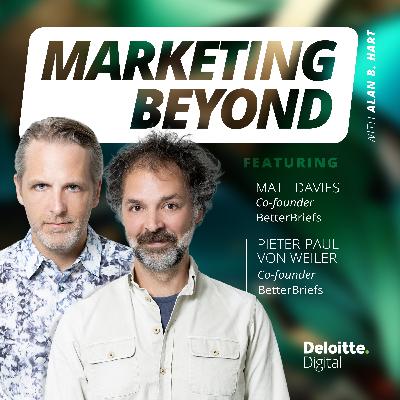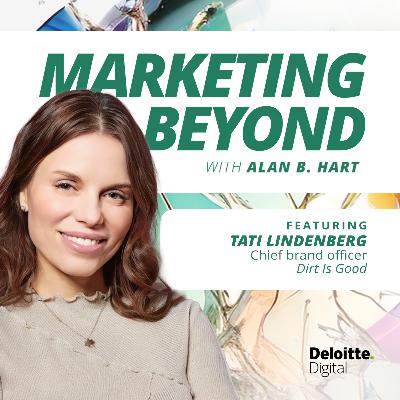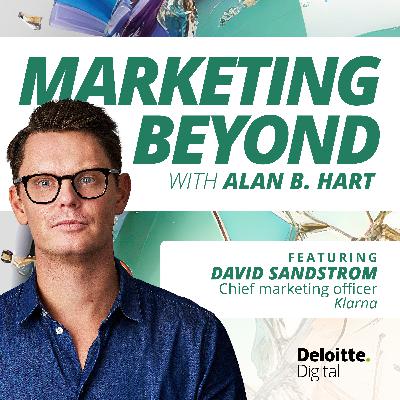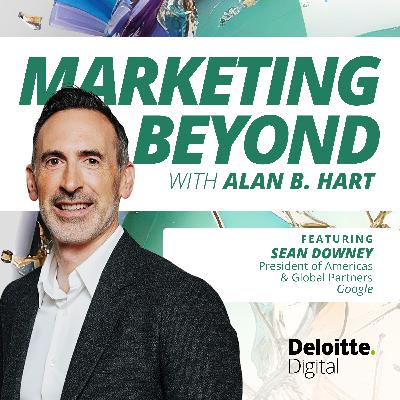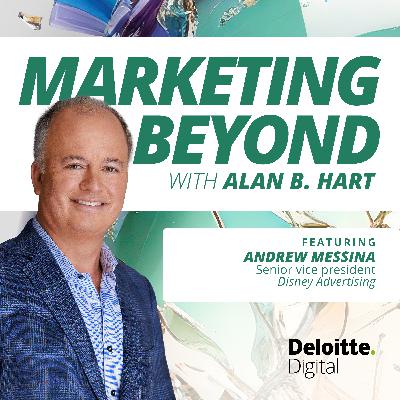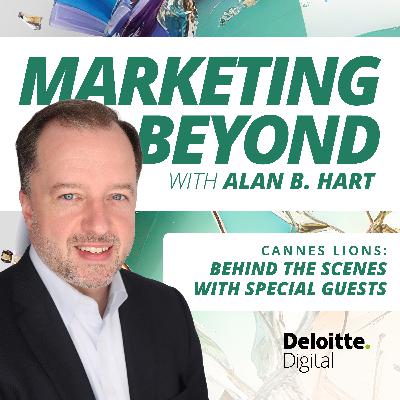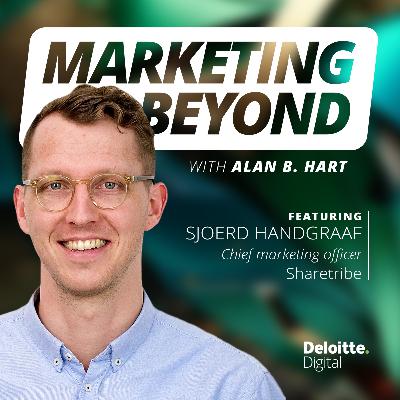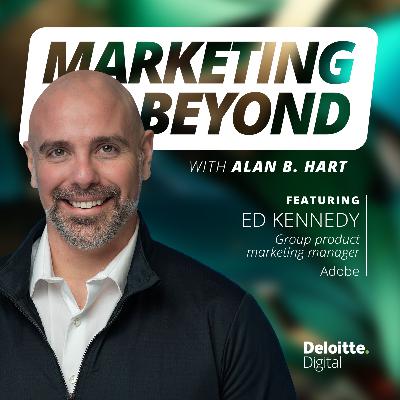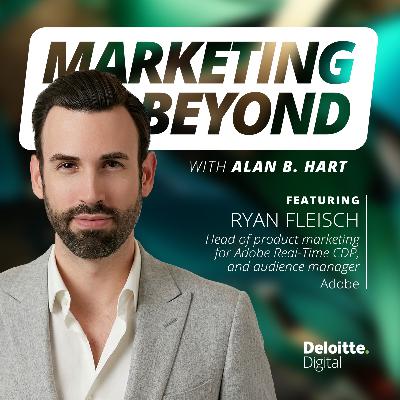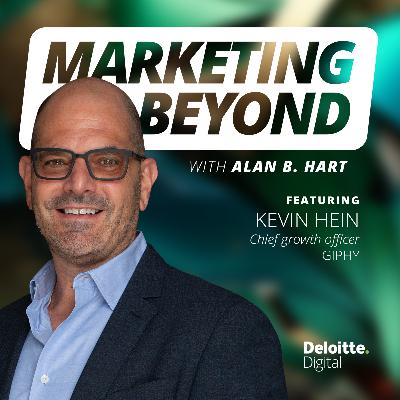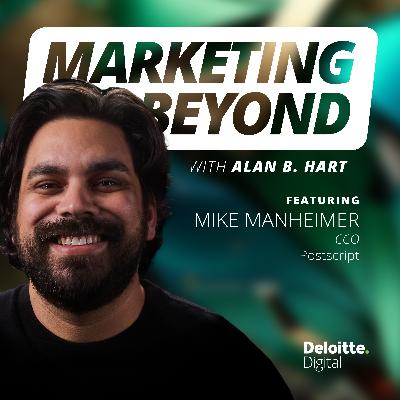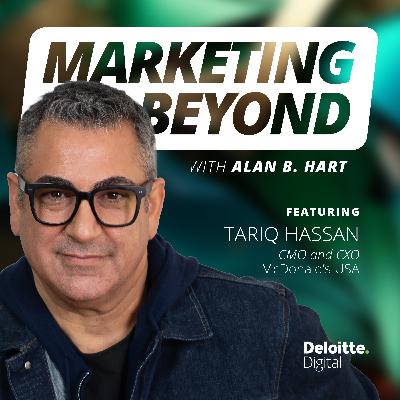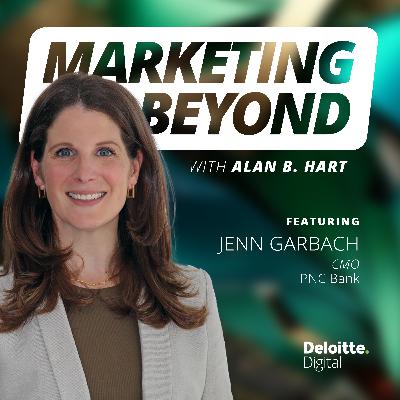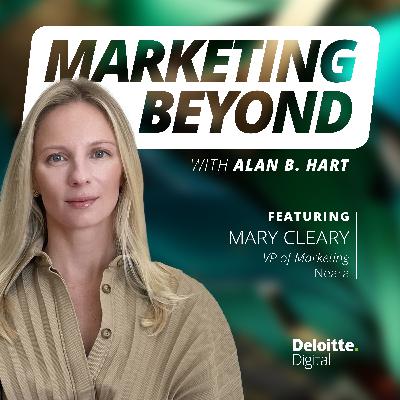Discover Marketing Beyond with Alan B. Hart
Marketing Beyond with Alan B. Hart

Marketing Beyond with Alan B. Hart
Author: Alan B. Hart
Subscribed: 261Played: 6,979Subscribe
Share
© 2025
Description
Join Alan B. Hart as he dives into conversations with the world’s leading chief marketing officers and business innovators. Tune in to get inspired by the stories and experiences of marketing visionaries—and stay ahead of the curve.
21 Episodes
Reverse
In today’s episode, Alan sits down with BetterBriefs co-founders Matt Davies and Pieter-Paul von Weiler to discuss why they think marketing briefs are the most important document in the agency-marketer relationship, how approaching briefs as contracts may influence results, and the effect that clarity in briefs has on creativity. Matt and Pieter-Paul also share insights from the BetterBriefs Project, the first-ever global study on marketing briefs, revealing a widespread disconnect between marketers and agencies that can lead to billions in wasted budgets. In addition, they share findings from the follow-on BetterIdeas Project, showing that many brands lack criteria, tools and training to evaluate ideas properly, fueling the trust gap between agencies and marketers. Matt and Pieter-Paul have won more than 20 marketing effectiveness awards, including two Grand Effies. With decades of experience managing thousands of briefs across global markets, they bring deep expertise and practical insights on how to improve briefs and evaluate ideas more productively. Their company, BetterBriefs, trains marketers worldwide on how to brief better and realize more effective ideas. In this episode, you'll learn: Why poorly written briefs can waste large amounts of budget and stall creativity Ways to write better briefs that lead to more effective ideas Why treating marketing briefs as contracts improves agency results Strategies that help build trust between marketers and agencies for better collaboration Key quotes: “The more people we get to decide on which idea is right for our business, the more we end up being that child in kindergarten, mixing all the paint together. And we all know what kind of color we end up with.” - Pieter-Paul von Weiler, co-founder of BetterBriefs “If our strategy [in a brief] is ill-defined, we’re not setting agencies up for success.” - Matt Davies, co-founder of BetterBriefs “You commission an artist and let them roam free so they can do their best work. Agencies need to be guided... and they need to be informed on what they need to do and how they apply their commercial creativity.” - Pieter-Paul von Weiler, co-founder of BetterBriefs “Just because you have an opinion [on an idea] doesn’t mean that that opinion is informed [or] justified.” Matt Davies, co-founder of BetterBriefs Key highlights: [00:30] Introduction [02:30] Why are there two guests here? [03:20] The brutally honest collaboration origin story [08:50] Strategies to waste less money [11:35] The brief is a contract [14:45] Balancing clarity with room for creativity [17:55] Briefs versus ideas [19:00] Tips to improve relationships between markets and agencies [23:20] Contributing factors for poor idea assessments [28:00] An experience that defines you: Diversity of experience and getting fired [33:15] Advice to your younger self: Be a student of the industry and stop trying to outsmart everyone [35:15] Where marketing science fits in [38:15] Largest opportunity and threat to marketers today: Tighter budgets and the need to write fewer briefs while being more effective Resources mentioned: BetterBriefs BetterBriefs research 2021 marketing briefs study Apple’s “1984” Super Bowl Ad Sony Bravia's Bouncy Balls Guinness’s “Surfer” The Effie's The IPA Effectiveness Awards The Ehrenberg-Bass Institute for Marketing Science Dr. Byron Sharp Dr. Karen Nelson-Field Peter Field Les Binet Adam Morgan System1 Jan-Benedict Steenkamp Follow the podcast: Listen on Apple Podcasts Listen on Amazon Music Listen on Audible Listen on iHeart Radio Listen on Spotify Connect with Pieter-Paul von Weiler, Matt Davies, and BetterBriefs: Pieter-Paul von Weiler on LinkedIn Matt Davies on LinkedIn BetterBriefs on LinkedIn Connect with Alan Hart and Deloitte Digital: Alan Hart on X Alan Hart on LinkedIn Deloitte Digital on LinkedIn Deloitte Digital on Instagram Deloitte Digital on YouTube Deloitte Digital on Threads
In today’s episode, Alan wraps up our Cannes Lions International Festival of Creativity content series with Tati Lindenberg, chief brand officer at Dirt Is Good. Together, they explore global brand strategy for balancing consistency with local relevance, the origin and evolution of the Dirt Is Good brand, and the brand’s deliberate movement through distinct “eras.” Tati discusses the importance of identifying which parts of the brand are “sacred” and must remain unchanged, versus those elements that can be evolved and iterated to stay culturally relevant. She notes the brand’s intentional move to highlight women athletes as main characters, showing its response to evolving consumer expectations. Drawing on her experiences as a mother and her life across multiple countries, Tati shares how these perspectives have shaped her approach to global brand strategy and her management of a diverse portfolio of brands across regions. As a highly awarded marketer, she offers insights into the role of industry recognition in building high-performing teams. She emphasizes the importance of maintaining brand distinctiveness while encouraging influencer authorship. Tati also reflects on the future of creativity in an artificial intelligence-driven landscape, her concerns about the growing "sea of sameness" in marketing, the dynamics of superfan culture, and the value of taking life a bit less seriously. In this episode, you'll learn: Ways to balance a global brand strategy with local execution How Dirt Is Good has evolved while maintaining consistency and relevance The impact advertising awards have on creativity and execution Key quotes: “We understand what trends are happening out there, what the company strategy is, and try to combine those two things to maintain the fresh brand.” - Tati Lindenberg, chief brand officer at Dirt Is Good “I’m really concerned that everybody seems to be doing the same thing... we need to keep asking ourselves, are we modern enough? Are we culturally relevant? Are we compelling enough for consumers?” Tati Lindenberg, chief brand officer at Dirt Is Good Key highlights: [00:30] Introduction [01:25] From São Paulo to the United Kingdom [03:45] Tati’s path to Dirt Is Good [07:55] The scope of the fabric cleaning business [09:50] Balancing a global brand strategy with local execution [12:45] The Dirt Is Good origin story [15:20] A new way to manage brand portfolio [17:00] Balancing consistency with fresh ideas [20:50] In their women’s sports era [22:00] The importance of awards [24:40] An experience that defines you: Coca-Cola Christmas [28:10] Advice to your younger self: Take it easy [29:35] A topic marketers need to learn more about: Availability and affordability of tools [32:45] Subcultures and trends to follow: Superfans [33:45] Largest threat for marketers: “The sea of sameness” Resources mentioned: Cannes Lions International Festival of Creativity Dirt Is Good Arsenal Football Club Follow the podcast: Listen on Apple Podcasts Listen on Amazon Music Listen on Audible Listen on iHeart Radio Listen on Spotify Connect with Tati Lindenberg and Dirt Is Good: Tati Lindenberg on LinkedIn Tati Lindenberg on Instagram Dirt Is Good on LinkedIn Dirt Is Good on Instagram Connect with Alan Hart and Deloitte Digital: Alan Hart on X Alan Hart on LinkedIn Deloitte Digital on LinkedIn Deloitte Digital on Instagram Deloitte Digital on YouTube Deloitte Digital on Threads
In today’s episode, we continue our Cannes Lions series as Alan and David Sandstrom, chief marketing officer at Klarna, discuss how embracing change, leveraging artificial intelligence (AI), and balancing data-driven efficiency with creativity are shaping the future of marketing and brand-building. Klarna is a financial technology company that is well-known for its "buy now, pay later" (BNPL) options. David highlights the macroeconomic trends that he believes are contributing to the continuing growth of BNPL, while also sharing Klarna’s efforts to diversify their offerings with digital banking and mobile phone plans. Innovation and experimentation are core to Klarna’s culture, and can be seen in initiatives like their interactive customer hotline featuring an AI avatar of their chief executive officer. David also outlines how he and his team encourage employees to use AI internally by actively measuring AI usage, using it as a team on a daily basis, and challenging team members to complete tasks that would be impossible without it. However, despite Klarna embracing AI usage and adopting new technologies, David emphasizes the essential role of human creativity in creating resonant messaging. He also discusses his interest in “anti-trends”, like long-form content, as open spaces to build brands and tell stories. In this episode, you'll learn: How building an AI-driven culture can boost innovation and efficiency Why combining technology with creativity can be key to brand success How expanding and educating beyond your core offering can drive growth Key quotes: “We’re not doing anything new based on AI. We’re only doing the things we used to do, but way more efficiently, way faster, at a way lower cost.” - David Sandstrom, chief marketing officer at Klarna “I think our investment in AI culture has been more important than our investment in AI infrastructure” - David Sandstrom, chief marketing officer at Klarna Key highlights: [00:30] Introduction [01:05] What’s new for Klarna [01:50] David’s career path [03:25] The key to David’s CMO longevity [04:00] Growth of BNPL [05:20] Extending beyond BNPL [06:15] Moving to digital banking [08:00] Creating a culture to embrace AI [11:30] The impact of AI on the creative process [13:40] An experience that defines you: Being born to a juxtaposing pair [14:25] Advice to your younger self: Enjoy the ride [14:55] A topic marketers need to learn more about: How to build a brand today [16:00] Subcultures and trends to follow: Anti-trends and long-form [17:30] Largest threat to marketers today: Becoming too data-driven Resources mentioned: Cannes Lions International Festival of Creativity Klarna’s AI chief executive officer report Follow the podcast: Listen on Apple Podcasts Listen on Amazon Music Listen on Audible Listen on iHeart Radio Listen on Spotify Connect with David Sandstrom and Klarna: David Sandstrom on X David Sandstrom on LinkedIn Klarna on X Klarna on LinkedIn Klarna on Instagram Connect with Alan Hart and Deloitte Digital: Alan Hart on X Alan Hart on LinkedIn Deloitte Digital on LinkedIn Deloitte Digital on Instagram Deloitte Digital on YouTube Deloitte Digital on Threads
Sean Downey is the president of Americas & Global Partners at Google, overseeing the company’s expansive advertising business, including Google Search and YouTube. With a background rooted in the earliest days of digital marketing startups and leadership roles at DoubleClick and Google, Sean draws on leadership lessons learned from his father, particularly the importance of creating a workplace where everyone feels they are contributing to something greater than themselves. He emphasizes authenticity, empathy, and continuous learning as core leadership values. As part of our Cannes Lions content series, Alan and Sean connect at the International Festival of Creativity to discuss AI’s impact on marketing. Sean explains how Google integrates AI and automation into its advertising platforms to help marketers achieve better results while protecting consumer privacy. He notes that marketers today have to be more efficient than ever and highlights how AI-powered tools help them work smarter and adapt to rapidly changing consumer behaviors. Sean also stresses the importance of first-party data, privacy-safe solutions, strong change management, and a growth mindset for teams navigating technological shifts. In this episode, you'll learn: The ways Google balances consumer privacy with marketing performance Why change management and a growth mindset are essential as technology evolves Strategies Google uses to empower brands and agencies to confidently adopt and leverage AI-powered tools Key quotes: “Brands can get caught in the trap of thinking they know exactly who their customer is. When in reality, they're looking for people that they didn't know existed, that are incremental to their business.” - Sean Downey, president of Americas & global partners at Google “Everyone knows when they walk to the doors in my building that they contribute to something greater than that. And that powers innovation, that powers customer orientation, and most importantly, it empowers growth personally and professionally.” - Sean Downey, president of Americas & global partners at Google Key highlights: [00:30] Introduction [01:15] Work-life balance [02:45] Sean’s path to Google [04:20] A North Carolina connection [05:10] The scope of Google’s advertising business [07:15] Balancing privacy with marketing effectiveness [09:25] Three tips for brands [10:45] How AI is influencing Google products [14:00] Empowering product adoption for brands and agencies [20:20] Sean's leadership principles [23:50] An experience that defines you: Learning from the most challenging times [26:45] Advice to your younger self: Be honest with yourself [27:35] A topic marketers need to learn more about: Change management [29:10] Subcultures and trends to follow: What makes people resonate [31:10] Largest opportunity to marketers today: The pace of ideas Resources mentioned: Sean Downey Google YouTube Cannes Lions International Festival of Creativity Follow the podcast: Listen on Apple Podcasts Listen on Amazon Music Listen on Audible Listen on iHeart Radio Listen on Spotify Connect with Sean Downey and Google Sean Downey on LinkedIn Google on LinkedIn Google on Instagram Google on YouTube Connect with Alan Hart and Deloitte Digital: Alan Hart on X Alan Hart on LinkedIn Deloitte Digital on LinkedIn Deloitte Digital on Instagram Deloitte Digital on YouTube Deloitte Digital on Threads
Andrew Messina is a Senior Vice President at Disney Advertising. He began his career on the agency side before moving into daytime sales at ABC, then advancing to a primetime senior account executive role, and ultimately rising to his current position. For the past 17 years, Andrew has led all brand advertising initiatives at Disney Advertising, including linear, programmatic, and addressable campaigns across platforms such as Disney, Disney+, Hulu, FX, and ESPN. In today’s episode, Alan and Andrew connect at the Cannes Lions International Festival of Creativity to discuss the integration, sponsorship, and advertising opportunities Disney offers brands across its many properties. Andrew shares how live events – particularly women’s sports – are shaping advertising, highlights the importance of relationship-building in media sales, and explains Disney’s approach to reaching diverse audiences. He also reflects on the importance of mentorship and how AI and youth culture are influencing marketing strategies. In this episode, you'll learn: How rising viewership of women’s sports is creating new advertising opportunities Why cultivating trust is essential for career growth, plus actionable development tips Disney’s approach to building relationships with brands Key quotes: “Relationships really, really matter, and the only way some of these things are going to get done is through making sure you’re connected.” - Andrew Messina, senior vice president at Disney Advertising Key highlights: [00:30] Introduction [01:10] A nontraditional introduction to the industry [02:15] Andrew’s path to Disney [04:10] The scope of his role [05:00] How consumer brands shape the sports landscape [07:45] Some of the most valued properties for brands [08:45] Co-creation with consumers [10:00] Stand-out strategies for auto and retail [11:30] Industry transformation over the years [13:25] An experience that defines you: The opportunity to learn sales [15:40] Advice to your younger self: Develop relationships [16:50] A topic marketers need to learn more about: AI [17:35] Subcultures and trends to follow: Tastes of the younger audience [18:50] Largest threat to marketers today: Complacency Resources mentioned: Disney Advertising Cannes Lions International Festival of Creativity College GameDay Built by The Home Depot Generation AI by Matt Britton Follow the podcast: Listen on Apple Podcasts Listen on Amazon Music Listen on Audible Listen on iHeart Radio Listen on Spotify Connect with Andrew Messina and Disney Advertising: Andrew Messina on LinkedIn Disney Advertising on LinkedIn Disney Advertising on X Disney Advertising on Instagram Connect with Alan Hart and Deloitte Digital: Alan Hart on X Alan Hart on LinkedIn Deloitte Digital on LinkedIn Deloitte Digital on Instagram Deloitte Digital on YouTube Deloitte Digital on Threads
Each year, top creative minds gather at the Cannes Lions Cannes Lions International Festival of Creativity for a week of innovations, awards, and candid conversations about the future of marketing. Over the next month, you will get exclusive insight into the latest trends and stories shaping the industry through interviews with leaders from some of the world’s most influential brands, including Google, Disney, and Unilever. In this episode, Alan kicks off the miniseries with our “crystal ball confessionals.” Unlike our usual one-on-one interview style episode, today you’ll hear snippets of Alan's conversations with industry leaders, creators, and innovators at Deloitte Digital’s exclusive ‘Collaborate with Certainty’ and ‘Engage with Certainty’ brunches. These short, candid conversations explore the future of marketing, focusing on the evolution of the creator economy, the changing landscape of fan engagement, and the role of data and technology in shaping authentic connections. Beginning at the ‘Collaborate with Certainty’ brunch, we explore how the creator economy transforms how brands connect with customers and drive growth. First, Celia Salsi, global head of product marketing at YouTube, shares her insights on why attention, relevance, and trust are crucial for brands striving to stand out in a crowded market. Building on this theme, Kaya Yurieff, team leader for the creator economy at The Information, explores creators' complex and evolving identities. Rounding out the conversation, Kenny Gold, Deloitte Digital’s head of social and creator, shifts the focus to AI, reminding us that, despite technological advances, the true impact of creators remains grounded in authentic human connection. Shifting to the ‘Engage with Certainty’ brunch, we tackle the question: What does the fan of the future expect from their entertainment experiences? First, we hear from Emma Simkiss, associate director of brand and marketing at the International Olympic Committee, on how authentic fan engagement is measured by meaningful interaction and loyalty, not just numbers. Michelle McGuire Christian, chief commercial officer for Converge™ by Deloitte for Sports, explains how leveraging data and AI can unlock deeper personalization and help brands truly listen to their audiences. Finally, David Geisinger, Marketing Technology, Data & Operations offering leader at Deloitte Digital, discusses a future where technology transforms fans from passive spectators into active participants, building vibrant two-way communities. Key quotes: “What we realized through research is that reach alone is no longer enough...They need attention, relevance, and trust. And what we've seen is that creators are best positioned to drive those three.” - Celia Salsi, Global head of product marketing at YouTube In this episode, you'll learn: The importance of building authentic, long-term relationships with creators The value of data in measuring creator impact and fan engagement Ways to leverage AI to create personalized connections with your audience Key highlights: [00:30] Episode introduction [02:50] The ‘Collaborate with Certainty’ brunch [03:00] Celia Salsi on the evolution of creator relationships [06:15] Kaya Yurieff on authentic connections for lasting engagement [08:15] Kenny Gold on the importance of genuine collaboration [10:20] The ‘Engage with Certainty’ brunch [10:30] Emma Simkiss on driving and measuring engagement [11:55] Michelle McGuire Christian on the role of data in engagement strategies [13:55] David Geisinger on how technology is impacting fan engagement [18:00] One-word summaries Resources mentioned: Cannes Lions International Festival of Creativity 2025 YouTube The Information Deloitte Digital Deloitte International Olympic Committee Converge™ by Deloitte for Sports Follow the podcast: Listen on Apple Podcasts Listen on Amazon Music Listen on Audible Listen on iHeart Radio Listen on Spotify Connect with the guests: Celia Salsi Kaya Yurieff Kenny Gold Emma Simkiss Michelle McGuire Christian David Geisinger Connect with Alan Hart and Deloitte Digital: Alan Hart on X Alan Hart on LinkedIn Deloitte Digital on LinkedIn Deloitte Digital on Instagram Deloitte Digital on YouTube
Are your ads landing with consumers? According to iHeartMedia's “The New American Consumer 2.0” study, 44% of Americans feel ignored by most media and advertisers .1 In today’s episode, Alan chats with Gayle Troberman, executive advisor at iHeartMedia, about the gap between marketers and consumers, ways for marketers to bridge this gap, and the marketing principles that stay consistent despite technological advancements. Gayle emphasizes the importance of balancing new technology with classic marketing approaches and cautions against neglecting potential customers by focusing too narrowly on the target audience. She highlights the power of evoking memories in advertising, primarily through audio, with examples of iconic jingles. She also describes why radio and podcasting are effective tools for mass reach and emotional engagement. Gayle Troberman is a highly respected marketing industry veteran. She spent 16 years as chief creative officer at Microsoft, then as chief marketing and ideas officer at IPG Mediabrands. She then became chief marketing officer at iHeartMedia for over a decade before moving into her current role as executive advisor. Today, Gayle works across all iHeartMedia businesses to help them connect with consumers in a deeper, more meaningful way. Her “human first, outcome second” approach to life and marketing has kept her consistently in tune with consumers throughout her career. In this episode, you'll learn: The inspiration behind “The New American Consumer 2.0” study and insights from the research How marketers can better understand their audience Approaches to using AI and targeting to add value from a consumer perspective Key quotes: “Every time a new technology comes along... marketers think it's like the world has to change, and it really doesn't. If you know who your brand is and you know where you want to find growth, then it's about telling good stories. It's about being relevant to those consumers.” - Gayle Troberman, executive advisor at iHeartMedia “We sometimes let innovation get in the way of growth, or we get so enamored with the technology or the opportunity that we forget any of these platforms, any of these news tools, whether it's AI or targeting, are only as good as the stories we put out there.” - Gayle Troberman, executive advisor at iHeartMedia “The average marketer may not be as in touch with their consumers as they think they are... I think part of the problem is that we're very often talking to ourselves. Our ads are reflecting this bubble we live in. Our ads are not reflecting the values, the beliefs, the interests, or the passions of the real American consumers.” - Gayle Troberman, executive advisor at iHeartMedia “There's genius out there everywhere if you just talk to humans.” - Gayle Troberman, executive advisor at iHeartMedia Key highlights: [00:32] Introduction [01:45] A ”muppalucky” life [02:50] Gayle’s career path [05:50] The secret to a long CMO tenure [07:45] Enduring truths in marketing [13:40] “The New American Consumer Report 2.0” [18:25] How marketers can reconnect with everyday consumers [22:40] Who has influence? [24:15] Using AI in a mindful way [28:30] An experience that defines you: Developing a human-first philosophy [31:30] Advice to your younger self: A little more patience and empathy [33:00] A topic marketers need to learn more about: Balancing the new with the classics [34:15] Subcultures and trends to follow: Young people taking strong stances [35:35] Largest opportunity and threat to marketers today: Fake performance indicators Resources mentioned: Gayle Troberman iHeartMedia "The New American Consumer 2.0" press release “The New American Consumer 2.0” study Follow the podcast: Listen on Apple Podcasts Listen on Amazon Music Listen on Audible Listen on iHeart Radio Listen on Spotify Connect with Gayle Troberman and iHeartMedia: Gayle Troberman on LinkedIn iHeartMedia on LinkedIn iHeartMedia on Instagram iHeartMedia on YouTube Connect with Alan Hart and Deloitte Digital: Alan Hart on X Alan Hart on LinkedIn Deloitte Digital on LinkedIn Deloitte Digital on Instagram Deloitte Digital on YouTube Deloitte Digital on Threads
How do you determine your product's market value beyond its features? In today’s episode, Alan and Sjoerd Handgraaf, Sharetribe's chief marketing officer (CMO), discuss Sharetribe’s origins, product evolution, and how Sjoerd’s team identified its ideal product positioning by evaluating the true value it provides to marketplace founders. Sjoerd shares insights into the unique dynamics of building and branding two-sided marketplaces and explains how a “give first, ask later” philosophy has helped Sharetribe develop trust and lasting relationships with its community. Sjoerd grew up as a do-it-yourself (DIY) punk rocker in a steel town in the Netherlands. He originally planned to become an English teacher, but love brought him to Finland, where he discovered the startup world. With his DIY background, Sjoerd joined Sharetribe as the first marketing hire in 2016 and became CMO in 2020. Sharetribe is a software as a service (SaaS) solution that aims to democratize the sharing economy by empowering marketplace founders with a no-code platform builder. Key quotes: “We just put value out in the world, and we hope that convinces people to at least give us a try.” - Sjoerd Handgraaf, chief marketing officer at Sharetribe “Look at what your [product’s] unique benefits are compared to those [competitive alternatives] and then try to wrap those [benefits] in value, not features. A lot of tech marketers are quite fond of listing the features, but what is the value that [the feature] unlocks? What is the thing that it gives to customers?”” - Sjoerd Handgraaf, chief marketing officer at Sharetribe In this episode, you'll learn: Common pitfalls to avoid when starting a marketplace business How to conduct an objective self-assessment to clarify positioning Sjoerd’s tips for marketers on navigating AI Key highlights: [00:30] Introduction [01:38] A punk record label mogul [03:00] The Dutch directness [05:15] Sjoerd’s path to Sharetribe [09:17] Who does Sharetribe serve? [10:40] Sharetribe’s origin story [16:30] How to get the product positioning right [33:27] The notion of “give first, ask later” [28:25] Why marketing is moving back to basics [31:15] Lessons learned from Two-Sided: The marketplace podcast [36:15] An experience that defines you: Being a DIY punk [37:20] Advice to your younger self: Be even more entrepreneurial [38:05] A topic marketers need to learn more about: AI is unavoidable [42:55] Subcultures and trends to follow: No-Code and Indie Hackers [44:35] Largest opportunity and threat to marketers today: Leveling up with AI Resources mentioned: Sjoerd Handgraaf Sharetribe Two-sided: The Marketplace Podcast The Lean Marketplace Follow the podcast: Listen on Apple Podcasts Listen on Amazon Music Listen on Audible Listen on iHeart Radio Listen on Spotify Connect with Sjoerd Handgraaf and Sharetribe: Sharetribe on X Sharetribe on Facebook Sharetribe on YouTube Connect with Alan Hart and Deloitte Digital: Alan Hart on X Alan Hart on LinkedIn Deloitte Digital on LinkedIn Deloitte Digital on Instagram Deloitte Digital on YouTube Deloitte Digital on Threads
Can streetwear be made with zero plastic? Eric Liedtke says it can be, and he is on a mission to systematically change the fashion industry by shifting away from petroleum-based materials to plant-based materials. In 2014, Eric was already a leader in the fashion industry as the Head of Sports Performance at Adidas when the issues of micro and nano plastics were brought to his attention. As a vegan who loves to surf, Eric could not turn away from the fact that his work in fashion was contributing to the problem. By 2019, he stepped away from his executive board position at Adidas to launch UNLESS Collective, a statement streetwear brand with a regenerative creation model, meaning their products are made sustainably using zero plastic and decompose into nutrient-rich soil. UNLESS was recently acquired by Under Armour, and with that acquisition, Eric was also hired as their executive vice president of brand strategy. In today’s episode, Alan and Eric talk about what the acquisition means for UNLESS Collective’s mission, how it fits into Under Armour’s larger strategy, and where Eric thinks the Under Armour brand can go. UNLESS is on the cutting edge of sustainable fashion, and solutions to many of its challenges are still being invented. The backing of Under Armour has empowered UNLESS to invest in the research needed to make Eric’s dreams a reality. With a background leading brands like Reebok, Eric also understands that UNLESS must meet consumers where they are and not ask them to compromise their tastes or budgets. Once the tech is fully developed and brought to market correctly, Eric believes they will truly transform the fashion industry. Key quotes: “People care. The [challenge] is they don’t want to compromise their taste or the quality of the product for their values, and they don’t want to compromise really too much on price.” - Eric Liedtke, executive vice president of brand strategy at Under Armour and founder and chief executive officer of UNLESS Collective “So, step one, get the value at the same level they’re [the customer is] expecting, get the quality at the same level they’re expecting, get the taste at the same level they’re expecting, [and] get it built on a better stack. Step two is scaling the brand and getting the volumes to hit the unit economics on par.” - Eric Liedtke, executive vice president of brand strategy at Under Armour and founder and chief executive officer of UNLESS Collective In this episode, you'll learn: How UNLESS is overcoming the challenges of manufacturing streetwear with zero petroleum-based materials Eric's strategy to bring innovative value-aligned products to market at scale The importance of authenticity in modern marketing Key highlights: [02:25] Eric's career path [06:40] The founding story of UNLESS [10:40] Zero wasted hours [13:20] The logistics of moving from plastic to plant-based [18:00] Evolving marketing with technology [21:30] Benefits of working with Under Armour [23:45] Propelling the Under Armour brand [27:15] An experience that defines you: Having purpose-led parents [30:10] Advice to your younger self: Don’t let perfect get in the way of better [31:25] A topic marketers need to learn more about: People want real [34:00] Subcultures to follow: Surf [35:40] Largest opportunity and threat to marketers today: AI and authenticity Resources mentioned: Eric Liedtke UNLESS Collective Under Armour Parley for the Oceans Follow the podcast: Listen on Apple Podcasts Listen on Amazon Music Listen on Audible Listen on iHeart Radio Listen on Spotify Connect with Eric Liedtke, UNLESS Collective, and Under Armour Eric Liedtke on LinkedIn Eric Liedtke on Instagram UNLESS Collective on Instagram UNLESS Collective on TikTok Under Armour on X Under Armour Instagram Connect with Alan Hart and Deloitte Digital: Alan Hart on X Alan Hart on LinkedIn Deloitte Digital on LinkedIn Deloitte Digital on Instagram Deloitte Digital on YouTube Deloitte Digital on Threads
What do executive recruiters look for when placing chief marketing officer (CMO) candidates? Why do CMOs have some of the shortest average tenures among the C-suite? Richard Sanderson has spent nearly his entire career as an executive recruiter. He began as an intern at Russell Reynolds Associates in the United Kingdom, then eventually joined them full-time, and was relocated to the United States. He went on to get his Master of Business Administration from the University of Chicago before shifting into a new role as Senior Associate at Booz & Company. After five years in consulting, Richard rejoined Russell Reynolds Associates before moving into his current marketing, communications, and sales practice leader role at Spencer Stuart. In his role, he has led a series of high-profile Fortune 500 chief marketing officer (CMO) searches. In today's episode, Alan and Richard break down the 2025 Chief Marketing Officer Tenure Study. They discuss what the data shows regarding career trajectories, changing titles and expectations, and the future of marketing leadership. Richard also shares what he seeks in CMO candidates when filling a role, provides listeners with actionable tips for interviews, and suggests that marketers align their language with their CEO’s priorities. In this episode, you'll learn: The ABCs of interviewing: Leading practices and common pitfalls Career paths for CMOs after their tenure What shifting marketing leadership titles means for the role Key quotes: “Yes, it's your resume that gets your foot in the door... but it's the chemistry and the culture that gets you the job.” - Richard Sanderson, marketing, sales, and communications practice leader at Spencer Stuart “Low tenure is not a sign of failure... Many marketing leaders are being promoted into bigger and better roles. So, in other words, short tenure [does not mean] a bunch of CMOs [are] being fired. It's quite the opposite... a bunch of CMOs being promoted and given other opportunities.” - Richard Sanderson, marketing, sales, and communications practice leader at Spencer Stuart “Ultimately, when you think about the constituents of the C-suite, who is the voice of the customer? Is it the chief financial officer? Not really. Is it the chief information officer? I don't think so. Is it the chief HR leader? No. Really... the marketing leader is the true customer or consumer advocate; they are the voice of the customer.” - Richard Sanderson, marketing, sales, and communications practice leader at Spencer Stuart Key highlights: [02:10] A new (destructive) addition to the family [03:35] Richard’s unusual path to executive recruiting [06:55] How to shine in the job search and interview [13:36] CMO tenure data [17:00] Why CEO tenure is an outlier [19:05] Where do the CMOs go? [23:45] Evolution of the CMO role in financial services and healthcare [26:05] Changing titles and responsibilities [29:05] The marketing to CEO pipeline [32:00] An experience that defines you: Living cross-culturally [34:35] Advice to your younger self: Treasure your time [36:15] A topic marketers need to learn more about: The shifts in industry and politicization of brands [40:30] Largest opportunity to marketers today: Align the agenda and talk the language Resources mentioned: Richard Sanderson Spencer Stuart 2025 CMO Tenure Study Follow the podcast: Listen on Apple Podcasts Listen on Amazon Music Listen on Audible Listen on iHeart Radio Listen on Spotify Connect with Richard Sanderson and Spencer Stuart Richard Sanderson on LinkedIn Spencer Stuart on X Spencer Stuart on Facebook Spencer Stuart on YouTube Connect with Alan Hart and Deloitte Digital: Alan Hart on X Alan Hart on LinkedIn Deloitte Digital on LinkedIn Deloitte Digital on Instagram Deloitte Digital on YouTube Deloitte Digital on Threads
What lessons can marketers learn from Taylor Swift’s massive success? In today's episode, Alan Hart talks with Kevin Evers, senior editor at Harvard Business Review and author of the book There’s Nothing Like This: The Strategic Genius of Taylor Swift, about the branding and strategy lessons marketers can learn from the record-breaking artist. He reveals what prompted him to write about Swift and the commonalities he discovered between Taylor, Jeff Bezos, Jerry Garcia, The Beatles, and Reddit's true crime communities. Kevin explains that since the start of her career, Taylor has created “blank space” for herself in crowded categories through innovative differentiation techniques, like insisting on writing her own songs as a teen girl for teen girls at a time when most hits on country radio were performed by men. He notes she has a classic entrepreneurial spirit that has helped her beat the odds and defy what the data said was possible to reach levels of fame beyond most people’s expectations. Kevin and Alan discuss the rebranding lessons marketers can learn from Taylor’s transition from country to pop music and noting how she integrates personal connection into every aspect of her approach while maintaining the allure of scarcity with her dedicated fanbase. Kevin suggests that Taylor Swift’s success goes beyond her songwriting talent and superstar status. He believes it’s her strategic marketing approach and deep connection with her fans that truly set her apart—a lesson that all marketers can learn from. Key quotes: "Her customer obsession is her secret sauce. Again, incredibly talented, a great songwriter, but talent isn’t necessarily a scalable asset, but she knows that her fans are a scalable asset.” - Kevin Evers, senior editor at Harvard Business Review “She sets high expectations and then she exceeds those expectations. And in most cases, she gives fans more than they maybe even deserve and I think that fan obsession is a big part of why her fans stick around for so long, and when she’s able to recruit new fans.” - Kevin Evers, senior editor at Harvard Business Review In this episode, you'll learn: The importance of Taylor Swift's “fan-first approach” Rebranding lessons from her shift from country to pop How Taylor has wisely evolved her marketing strategy over the years Key highlights: [01:30] Delayed speech created a great interviewer [03:00] Kevin’s unconventional path to Harvard Business Review [03:55] Where did the idea for his new book come from? [05:15] Taylor Swift as a brand [06:35] A “fans first approach” [12:00] Taylor’s approach to risk [14:00] Rebranding from country to pop [16:55] Pros and cons of fame [18:25] How Tayor's media strategy has shifted [24:45] Differentiation in a crowded category [28:45] An experience that defines you: Embracing the creative process [30:20] Advice to your younger self: It’s all going to be okay [33:20] A topic marketers need to learn more about: What will break through? [35:05] Subcultures to follow: Superfan subculture [36:10] Largest threat to marketers today: A crowded marketplace Resources mentioned: Kevin Evers Harvard Business Review There’s Nothing Like This: The Strategic Genius of Taylor Swift The Strategic Genius of Taylor Swift Grateful Dead Bootlegs Pear Jam Wishlist Deep Taylor Fandom on Reddit Follow the podcast: Listen on Apple Podcasts Listen on Amazon Music Listen on Audible Listen on iHeart Radio Listen on Spotify Connect with Kevin Evers and Harvard Business Review Kevin Evers on X Harvard Business Review on X Harvard Business Review on Instagram There’s Nothing Like This on Instagram Connect with Alan Hart and Deloitte Digital: Alan Hart on X Alan Hart on LinkedIn Deloitte Digital on LinkedIn Deloitte Digital on Instagram Deloitte Digital on YouTube Deloitte Digital on Threads
What if you could know how new creative would perform before you invest in it? This is the exact functionality Adobe's latest creative intelligence tools are working towards. In today's episode, Alan chats with Ed Kennedy, group product marketing manager at Adobe, to explore their new Generative AI (GenAI) tools. These tools provide a gateway for marketers to scale the impact of GenAI while maintaining the balance between cost efficiency and performance. Ed leads all the go-to-market strategy for Adobe's new GenAI products. This includes GenStudio for Performance Marketing which provides granular insights down to specific attributes of each ad, so marketers and creatives can work simultaneously to activate high-performing campaigns. GenAI is causing many agencies and brand leaders to reevaluate their operating model, but Ed tells Alan that Adobe believes in an "AI-created, human-perfected" approach. This means GenAI takes on the low-value, repetitive, mundane tasks in the creative process, and then humans review and approve. If “marketers are marketing to consumers or businesses, then the humans are going to be in the driving seat,” Ed notes in response to concerns around AI. He also outlines the best use cases for AI agents and cautions marketers against skepticism of this evolving technology. Key quotes: “We're big on "AI created, human-perfected" in all the go-to-market messaging that we're bringing out and helping CMOs understand they can do this.” - Ed Kennedy, group product marketing manager at Adobe “If you can look at the performance of the ad itself on the content or creative level, you can quickly double down on what's working and turn off what's not working. And I think that's where we're saving our clients spend because we're just not putting dollars behind bad creative or just underperforming creative.” - Ed Kennedy, group product marketing manager at Adobe “Our ultimate vision is that you should actually be able to score your creative before it ships – if it actually is going to perform well.” - Ed Kennedy, group product marketing manager at Adobe “We're trying to get to a place... where the brief becomes the new prompt. So instead of entering a prompt to get content, you submit your brief and ... the agent starts working for you.” - Ed Kennedy, group product marketing manager at Adobe In this episode, you'll learn: Potential business use cases for GenAI today How Adobe GenStudio is bringing marketers and creatives closer together through data What the future of marketing jobs may look like Key highlights: [01:25] Yoga for work-life balance [02:50] Ed’s path to Adobe [03:55] The scope of his role [04:30] GenAI to drive advertising performance [06:05] Versioning with GenAI [07:45] Reevaluating the operating model [10:05] Scaling the impact of GenAI [11:45] Cost efficiency versus performance [12:50] What is creative intelligence? [15:20] Bringing performance and creative closer to data [18:05] AI agents and internal evangelists [21:30] An experience that defines you: It’s a ride, not a race [25:25] Advice to your younger self: Drop the intensity and expectations [26:45] A topic marketers need to learn more about: F.I.R.E [28:10] What are you curious about: AI video generation [29:50] Largest threat to marketers today: Cynicism on the sidelines Resources mentioned: Ed Kennedy Adobe GenStudio Agentic AI GenAI Follow the podcast: Listen on Apple Podcasts Listen on Amazon Music Listen on Audible Listen on iHeart Radio Listen on Spotify Connect with Ed Kennedy and Adobe Ed Kennedy on X Ed Kennedy on LinkedIn Adobe Experience Cloud on X Adobe on X Adobe on Instagram Connect with Alan Hart and Deloitte Digital: Alan Hart on X Alan Hart on LinkedIn Deloitte Digital on LinkedIn Deloitte Digital on Instagram Deloitte Digital on YouTube Deloitte Digital on Threads
Ryan Fleisch is the head of product marketing for Adobe Real-Time Customer Data Platform (CDP), and audience manager at Adobe. He is also a recent first-time girl dad and Alan's go-to technology whisperer. Ryan has experience on both the agency and brand sides of digital marketing and has been with Adobe since 2014. His current role, coupled with his previous leadership roles in solution consulting, has allowed him to understand the technical nuances of marketing and advertising technology and the big-picture trends that are transforming the industry at large. In today’s episode, Alan and Ryan reconnect for another interview at Adobe Summit 2025 to discuss Adobe’s new marketer-first data collaboration tools and what marketing professionals need to know to help them stay ahead of the curve. When it comes to winning impressions in the crowded attention economy, using data wisely is the difference between standing out and blending in with the thousands of ads consumers see daily. Ryan also explains how agentic AI can help marketers move from data synthesis to action, allowing them to scale their impact as individuals and departments. Key quotes: “Agentic AI doesn't just understand my business data. It actually understands my business processes and my goals” - Ryan Fleisch, head of product marketing for Adobe Real-Time CDP, and audience manager at Adobe In this episode, you'll learn: How to understand the attention economy Why “clean sketches” may replace “clean rooms” What agentic AI could mean for your marketing strategy Key highlights: [02:05] “The sleep deprivation is real.” [03:30] Ryan’s path to Adobe [06:00] Understanding the attention economy [08:25] The data tradeoff between scale and accuracy [10:30] Launching Real-Time CDP evaluations [11:30] Old “clean rooms” versus new “clean sketches” [14:45] AI empowering humans to do what they do best [16:40] Generative AI versus agentic AI [20:10] Sorry Spock, Emotions Drive Business [22:45] An experience that defines you: Don't fear the bunk bed [25:30] Advice to your younger self: Look at the big picture [27:05] A topic marketers need to learn more about: Agentic AI and physical art [28:50] Subcultures to follow: Appreciate artists [29:35] Largest opportunity or threat to marketers today: Pairing content with data Resources mentioned: Ryan Fleisch Adobe Adobe Real-Time CDP Adobe Audience Manager Announcement of new Adobe Real-Time CDP collaboration Follow the podcast: Listen on Apple Podcasts Listen on Amazon Music Listen on Audible Listen on iHeart Radio Listen on Spotify Connect with Ryan Fleish and Adobe Ryan Fleisch on LinkedIn Adobe on X Adobe on Instagram Connect with Alan Hart and Deloitte Digital: Alan Hart on X Alan Hart on LinkedIn Deloitte Digital on LinkedIn Deloitte Digital on Instagram Deloitte Digital on YouTube Deloitte Digital on Threads
Kevin Hein is the chief growth officer (CGO) at GIPHY. He began his print publishing career with Ziff Davis when print and tech were merging. Here, he learned the fundamentals of strategic selling while working on the PC magazine account. Kevin joined GIPHY in August 2024 and has since been instrumental in transforming GIPHY into a unique platform that connects brands with audiences through messaging. Under his leadership, GIPHY has expanded its advertiser base, introduced innovative ad formats, and positioned itself as a key player in the messaging ecosystem, driving significant revenue growth and delivering exceptional client results. Kevin joins Alan Hart at South by Southwest (SXSW) to discuss the unique positioning GIPHY offers brands–to become part of cultural conversations in an additive rather than intrusive way. GIPHY's daily reach touches over 1 billion people worldwide, creating a magical moment when users discover the perfect GIF to convey what words alone cannot. GIPHY collaborates with brands to seamlessly integrate their messages into this magic, transforming existing creative, optimizing new ideas, and experimenting in safe, engaging ways that drive organic, long-term results. Kevin explains the collaboration process with GIPHY, why he thinks all brands need to experiment with creativity, and what marketers can learn from innovative online content creators. Key quote: “The beauty and the elegance [of] GIPHY is that it’s part of the conversation. It’s not intrusive, it’s additive. It’s a natural extension of what you're talking about.” - Kevin Hein, Chief growth officer, GIPHY In this episode, you'll learn: How brands can influence culture without being intrusive What collaboration looks like with GIPHY The value of creative experimentation Key highlights: [01:20] For the love of car detailing [02:45] Kevin's path to GIPHY [05:40] Understanding GIPHY today [08:48] Where to go when you’re already everywhere [10:45] What makes GIPHY unique [13:05] Cut downs and brand collaborations [16:30] Where dexterity meets data [19:20] Making magic with Mug Root Beer [24:50] Investing in safe experimentation [26:10] An experience that defines you: “It’s just a chapter” [28:10] Advice to your younger self: Give people space to prove you wrong [29:55] A topic marketers need to learn more about: AI experimentation [32:50] Subcultures to follow: Innovative online creators [39:55] Why experiment when everything is going great [44:10] Largest opportunity or threat to marketers today: Test and learn Resources mentioned: Kevin Hein GIPHY GIPHY Studios GIPHY's daily reach statistic Mug Root Beer and Mug Root Beer on GIPHY Waz up Super Bowl Commercial Justin Flom, magician and YouTuber Follow the podcast: Listen on Apple Podcasts Listen on Amazon Music Listen on Audible Listen on iHeart Radio Listen on Spotify Connect with Kevin Hein and GIPHY: Kevin Hein on LinkedIn GIPHY on X GIPHY on Instagram Connect with Alan Hart and Deloitte Digital: Alan Hart on X Alan Hart on LinkedIn Deloitte Digital on LinkedIn Deloitte Digital on Instagram Deloitte Digital on YouTube Deloitte Digital on Threads Post-production credits: Integrity Media Solutions LLC
Mike Manheimer is the chief customer officer (CCO) at Postscript—and a soon-to-be first-time father. Postscript is a short message system (SMS) marketing platform powered by AI, designed to help e-commerce brands within the Shopify ecosystem build personalized connections with their customers to drive revenue. Mike entered the SaaS world straight out of college at a startup called WebPT, where he worked his way up to marketing director. After leaving WebPT, Mike held various leadership roles at Gainsight before serving as head of growth marketing at Front. He joined Postscript in 2021 as chief marketing officer and transitioned to his current role as chief customer officer in late 2024, leading both the marketing and customer teams. In today’s episode, Alan and Mike discuss conversational commerce, exploring how SMS text messaging, chatbots, and voice assistants are transforming the shopping experience. They examine the potential rise of SMS texts in marketing and why conversational commerce hasn’t fully taken off yet. Their conversation also highlights Postscript's decision to specialize rather than consolidate, and the AI innovations they are using to boost revenue. Mike also shares common misconceptions about SMS marketing, notes a consumer shift toward analog experiences, and encourages marketers to adopt an AI-first mindset. Key quotes: “When I joined Postscript, part of my thesis was that two megatrends were intersecting, and they weren’t going to stop: We’re seeing more transactions done online over time. The second is, we see messaging as a major component of the way people spend their time online, especially on their mobile devices. We see messaging in a bunch of forms but especially text messaging dominates the time people are using their phones. And so, Postscript exists at the intersection of both those trends.” – Mike Manheimer, CCO at Postscript “SMS is the only channel that exists for marketers that is fundamentally ‘two-way’ from the get-go.” – Mike Manheimer, CCO at Postscript “When you nail that—you know, the voice, the value add, and the consent—then what you end up with is a very highly engaged, high-earning channel. And a lot of people are finding that they're actually making more money off of an SMS list that ends up being only one-fifth of the size of the email list that they've been cultivating over the last few years because of the integration with the phone, the immediacy of the channel, and the engagement that you're able to generate.” - Mike Manheimer, CCO at Postscript “Cracking the code on conversational for your brand not only makes you feel good, it’s a financial imperative.” - Mike Manheimer, CCO at Postscript In this episode, you'll learn: Why SMS is yielding results in conversational commerce Benefits of specialization versus consolidation in SaaS What AI innovations are driving revenue Key highlights: [01:40] Preparing for fatherhood [03:10] Career path to Postscript [06:45] What is Postscript? [8:15] How SMS could change conversational commerce [12:10] Marketers’ SMS misconceptions [17:45] Specialization versus consolidation [23:20] AI use cases in SMS to drive revenue [30:55] Learning to adapt as the new kid [34:15] Advice to your younger self [36:20] A topic that you and other marketers need to learn more about: effectiveness in statistics [30:30] Trends or subcultures others should follow: a renewed interest in analog [41:40] Largest opportunity or threat to marketers today: become an AI-first thinker Resources mentioned: Mike Manheimer Postscript Shopify What is conversational commerce? Career stops: WebPT, Gainsight, Front Follow the podcast: Listen on Apple Podcasts Listen on Amazon Music Listen on Audible Listen on iHeart Radio Listen on Spotify Connect with Mike Manheimer and Postscript: Mike Manheimer on LinkedIn Postscript on X Postscript on LinkedIn Postscript on Instagram Postscript on TikTok Postscript on Facebook Connect with Alan Hart and Deloitte Digital: Alan Hart on X Alan Hart on LinkedIn Deloitte Digital on LinkedIn Deloitte Digital on Instagram Deloitte Digital on YouTube Deloitte Digital on Threads Post-production credits: Integrity Media Solutions LLC
Tariq Hassan is a proud girl dad, a transformational leader, and the chief marketing and customer experience (CX) officer at McDonald’s USA. Before joining McDonald’s, Tariq spent over 20 years in global marketing, communications, innovation, and consumer insights. Before moving into his first chief marketing officer role at Petco, he held marketing and brand leadership roles at HP, Omnicom Group, and Bank of America. Since joining McDonald’s in 2021, Tariq has led the post-pandemic marketing efforts, including digital, media, CRM, brand content and engagement, consumer insights, and menu strategy to create holistic and compelling brand experiences for customers across nearly 14,000 McDonald’s restaurants in the US. On today’s show, Alan and Tariq discuss Tariq’s career at McDonald’s and how he has helped bring the iconic brand into the digital future. They also explore how McDonald’s has modernized its approach to digital engagement and solidified its cultural relevance by mindfully using data and digging deep into “fan truths.” Tariq shares the four key areas that fueled this transformation: influencing food culture, deeply engaging with fans, leveraging data for personalization, and using McDonald’s influence to shape cultural moments. In this episode, Alan and Tariq also explore the return of McDonald’s beloved characters and the leadership lessons Tariq is taking with him as he moves on to his next career venture. Tariq opens about his personal experiences, including navigating the college search as a dad and how his daughter’s cancer journey influenced his outlook. Finally, he offers advice to brand leaders, reflects on AI’s growing role in marketing, and highlights food culture as a key trend for the future. Key quotes: “Data is a currency, it’s a language, it’s a form of connecting with [Gen Z], and if you do it the right way and provide value, then they return that value with a deeper relationship.” - Tariq Hassan, Chief marketing and customer experience officer, McDonald’s USA “At McDonald’s, we’re guided by what we call fan truths. These truths are about understanding the unique moments, those connections, that our fans have [with our brand].” - Tariq Hassan, Chief marketing and customer experience officer, McDonald’s USA “As brand leaders, you drive clarity of your values, you're transparent with those, and then you lead with actions.” - Tariq Hassan, Chief marketing and customer experience officer, McDonald’s USA In this episode, you'll learn: Why consistency is key to maintaining brand integrity Strategies for building deeper customer relationships through personalization Tips for embracing digital transformation and data-driven marketing Key highlights: [01:24] Experiencing the college search as a dad [03:35] Tariq’s career path to McDonald’s [07:28] Applying a customer-focused lens across industries [08:54] Where to start when stepping into an iconic brand [10:40] Four key areas driving McDonald’s modernization [12:43] The return of McDonald’s classic characters and their impact [17:18] The journey of McDonald’s digital transformation [20:15] Understanding the scale and reach of McDonald’s [21:11] Advice to brand leaders on navigating social, health, and other major events [24:24] Leadership principles Tariq is leaving at McDonald’s as he moves on [27:50] An experience from your past that defines you: his daughter's cancer journey [30:36] Advice to your younger self: trust your gut, find mentors, take a step back [32:08] A topic that you and other marketers need to learn more about: Generative AI [34:50] Trends or subcultures others should follow: food culture [36:15] Largest opportunity or threat to marketers today: data Resources mentioned: Tariq Hassan McDonald’s Career stops: Agencies – Darcy, Leo Burnett, FCB, Omnicomm. Brands: HP, Bank of America, Petco McDonald’s Celebrity Meals Hamburglar Hits the Road Grimace’s Birthday McDonald’s Mobile App Success “It’s not just you: McDonald’s really was everywhere this year” (CNN) Follow the podcast: Listen on Apple Podcasts Listen on Amazon Music Listen on Audible Listen on iHeart Radio Listen on Spotify Connect with Tariq Hassan and McDonald’s: Tariq Hassan on LinkedIn Tariq Hassan on X McDonald’s on X McDonald’s on Instagram Connect with Alan Hart and Deloitte Digital: Alan Hart on X Alan Hart on LinkedIn Deloitte Digital on LinkedIn Deloitte Digital on Instagram Deloitte Digital on YouTube Deloitte Digital on Threads Post-production credits: Integrity Media Solutions LLC
Jenn Garbach is the chief marketing officer at PNC Bank, where she leads a team of approximately 200 marketing professionals. Her team focuses on brand and line-of-business marketing, paid and social media, direct marketing, and digital marketing strategies. She also helps oversee the bank's relationship with Arnold Worldwide, PNC’s integrated marketing and advertising agency of record. With over 20 years of experience in financial and professional services, Jenn has worked across marketing, product management, strategy, technology, and customer experience. She began her career at Deloitte Consulting, and before joining PNC in June 2023, she held leadership roles at PayPal, Capital One, and Thomson Reuters. On today’s show, Alan and Jenn discuss her career journey, her initial goals upon joining PNC and the complexities of launching a new brand for a 160-year-old organization. They explore how marketing, often seen as “just pretty pictures,” is actually a key growth driver, a concept they refer to as “The Big M.” Jenn also breaks down the fundamental premise and strength of the “Yes, And” model and how it fuels innovation and collaboration. Looking ahead, they discuss AI preparedness and its impact on marketing. Key quotes: “You can’t just go out with a really funny, creative ad campaign and hope that it’s going to do the job. You have to live your brand every single day—and the products, services, experiences we are bringing to market.” - Jenn Garbach, CMO at PNC Bank “You hear me use that word ‘engine.’ That’s really the aspiration. Moving from a place where we may be operated as a delivery function to a place where marketing is seen as an investment of growth—marketing as an engine to drive business outcomes.” Jenn Garbach, CMO at PNC Bank “It’s not just about getting to the summit; it's the process we go about and the collective victory.” Jenn Garbach, CMO at PNC Bank In this episode, you'll learn: Strategies to gain a competitive edge Tips to enhance your marketing efforts using data-driven techniques How to transform your team into powerful change agents Key highlights: [01:28] Jenn’s first job as a cart pusher [02:48] Jenn’s career path [06:19] Initial goal when joining PNC [07:00] What is involved in launching a new brand [08:45] “Brilliantly Boring” tagline [12:51] Where does marketing go at PNC now? [15:07] How people become a great change agent [21:10] An experience from your past that defines you: studying abroad. [23:50] Advice to your younger self [25:05] A topic that you and other marketers need to learn more about: AI preparedness [28:10] Trends or subcultures others should follow: Super Bowl [30:22] Largest opportunity or threat to marketers today: pace of change Resources mentioned: Jenn Garbach PNC Financial Brilliantly Boring at PNC Boring is Essential (Launch Video) Follow the podcast: Listen on Apple Podcasts Listen on Amazon Music Listen on Audible Listen on iHeart Radio Listen on Spotify Connect with Jenn Garbach and PNC Bank: Jenn Garbach on LinkedIn PNC Bank on X PNC Bank on Instagram Connect with Alan Hart and Deloitte Digital: Alan on X Alan on LinkedIn Deloitte Digital on LinkedIn Deloitte Digital on Instagram Deloitte Digital on YouTube Deloitte Digital on Threads Post-production credits: Integrity Media Solutions LLC
Tom Klein is the Chief Marketing Officer at Matterport. He brings more than 20 years of experience spearheading marketing efforts for some of the world’s leading brands and has a passion for operating at the intersection of marketing and technology. Before Matterport, Tom served as the Global Chief Marketing Officer of Mailchimp, where he led the company’s go-to-market efforts and the brand, product, campaign, and content teams. In 2017, Adweek recognized Tom as one of the 50 Most Indispensable Executives in Marketing, Media, and Tech. Before joining Mailchimp, Tom founded and became CEO of Digital Scientists, a digital marketing and software development firm. He is also the co-author of the book, Enterprise Marketing Management: The New Science of Marketing. Matterport is a technology company specializing in 3D spatial data and virtual tour solutions. They provide a platform that enables users to digitize physical spaces into immersive, interactive 3D models known as digital twins. These digital replicas are widely used in real estate, construction, retail, and various other industries to improve visualization, design, and communication. On today’s show, Alan and Tom dive into the world of Matterport and explore the diverse range of customers it serves. They unpack the complexities of Matterport’s go-to-market strategy, which seamlessly integrates an eCommerce platform, professional services, and a robust SaaS offering. The conversation also ventures into the future of property intelligence, shedding light on how these innovative solutions are transforming industries and redefining the way we understand and utilize spatial data. “It can be very hard to reach the whole planet, but if you reach the people that are really the great communicators and connectors, that’s sort of a leverage point.” In this episode, you'll learn: The power of transforming complexities into a seamless experience for the customer Strategies for marketing to a diverse and dynamic consumer base What’s next for 3D spatial data technology Key Highlights: [02:22] Becoming a pro at refurbishing old houses [03:31] How refurbishing skills are similar to marketing [05:10] Journey to Matterport [07:08] Solutions Matterport provides [10:55] Data as a part of Matterport solutions [16:18] How Matterport solutions get out to market [21:50] What marketing looks like at Matterport [23:56] Where the technology of Matterport is going [28:02] An experience from your past that defines you [30:37] Advice to your younger self [32:38] A topic that you and other marketers need to learn more about [35:12] Trends or subcultures others should follow [37:45] Largest opportunity or threat to marketers today Resources Mentioned: Tom Klein Matterport Previous Marketing Today episode with Tom as CMO of Mailchimp Property Marketing Facilities Management Design & Construction Enterprise Marketing Management: The New Science of Marketing (2003 book by Tom) Follow the podcast: Listen on iTunes (link: http://apple.co/2dbdAhV) Listen on Google Podcasts (link: http://bit.ly/2Rc2kVa) Listen on Spotify (Link: http://spoti.fi/2mCUGnC) Connect with the Guest: https://www.linkedin.com/in/tklein/ https://x.com/tomklein https://x.com/Matterport https://www.instagram.com/matterportmedia Connect with Alan Hart, and Deloitte Digital: Alan on X Alan on LinkedIn Deloitte Digital on LinkedIn Deloitte Digital on Instagram Deloitte Digital on Youtube Deloitte Digital on Threads Post-Production Credits: Integrity Media Solutions LLC
Andy Lopez is the Senior Vice President and Head of North America Marketing at Behr and proud father to three children under the age of eight. At Behr, Andy leads the Brand Marketing department overseeing global B2C and B2B brand strategy, creative, media, PR, design, digital, innovation, consumer experience, and research. As the youngest Global Head of Marketing in Behr's 75+ year history, Andy has played a key role in maintaining BEHR’s position as the Most Trusted Paint brand in the U.S. and Canada. Before joining Behr, he held senior roles at leading global creative agencies such as Saatchi & Saatchi, and Project Worldwide, managing marketing strategies for Fortune 500 brands across diverse industries. Andy is recognized as one of the top marketers driving change in the industry. On today’s show, Alan and Andy discuss Andy's career journey and the fascinating process behind Behr's Color of the Year program, from how the colors and their names are created to the marketing strategies that bring them to life. They also explore Behr's successful social media efforts, including their growing presence on TikTok, and their strong partnership with The Home Depot. In addition, Andy shares how Behr builds excitement and drives purchases across the paint category while staying at the forefront of consumer engagement. “Strategize and make sure that we have collective marketing efforts that are really going to engage our DIY and professional audience the way that we feel like is truly going to make an impact and grow our businesses.” In this episode, you will learn: The secret behind the Color of the Year program, from selection to naming Tips to successfully build your social media presence Strategies to build and maintain a strong partnership Key Highlights: [01:32] Life as a father of 3 kids under the age of 8 [03:26] Career path [04:54] Size and scope of Behr? [06:24] Why the Color of the Year (COTY) program began [07:41] How the COTY is chosen [09:10] How the name for the COTY is picked [11:08] Driving interest and purchases across the paint category with COTY [14:41] Achieving success on Tik Tok [16:46] Partnership with The Home Depot [18:53] A past experience that defines you [20:27] Advice to your younger self [21:17] A topic that you and other marketers need to learn more about [22:54] Trends or subcultures others should follow [25:04] Largest opportunity or threat to marketers today Resources Mentioned: Andy Lopez BEHR BEHR Color of the Year Partnerships with Olive & June for nail polish TikTok “To DIY for” Series The Home Depot & BEHR Follow the podcast: Listen on iTunes (link: http://apple.co/2dbdAhV) Listen on Google Podcasts (link: http://bit.ly/2Rc2kVa) Listen on Spotify (Link: http://spoti.fi/2mCUGnC) Connect with the BEHR and Andy Lopez: https://www.linkedin.com/in/andrewstevenlopez/ https://x.com/BehrPaint https://www.tiktok.com/@behr Connect with Alan Hart, and Deloitte Digital: Alan on X Alan on LinkedIn Deloitte Digital on LinkedIn Deloitte Digital on Instagram Deloitte Digital on Youtube Deloitte Digital on Threads Post-Production Credits: Integrity Media Solutions LLC
Mary Cleary is the VP of Marketing, Communications, and Public Policy at Neara. Under her leadership, Neara has grown from its Australian roots to establish significant presences in Europe and the U.S. Mary's unique approach to marketing in risk mitigation reflects her deep sensitivity and empathy, honed through her diverse career journey. Beginning in mergers and acquisitions at Rothschild, Mary discovered her passion for being an operator and marketer, which led her to roles in product marketing and communications at companies like MediaMath, News Corporation, and Frame AI. With a B.A. in Entrepreneurship and History from NYU, and even an early stint as a PR intern for Zac Posen, Mary brings a rich tapestry of experiences, driving innovative strategies and meaningful impact in the complex landscape of AI-powered infrastructure solutions. Neara is an infrastructure modeling platform revolutionizing how utility companies prevent outages and enhance transmission capacity. Recognized as one of TIME's 100 Most Influential Companies, Neara stands out for its transformative impact on utilities worldwide, enabling them to mitigate weather-related risks and improve resilience against potential disruptions. Beyond risk management, Neara’s advanced AI network modeling is a pivotal tool in advancing the global clean energy transition, helping utilities identify and address risks swiftly, assess the scope of potential issues, and streamline communication with policymakers to drive timely and informed decisions. On today’s show, Alan and Mary explore how the intersection of marketing and public policy shapes her strategic approach at Neara. They discuss the unique challenges of marketing in a regulated industry, highlighting the intricate balance required to navigate both compliance and creative engagement. They also discuss the complexities of managing international marketing activities and how the global scope amplifies these challenges. Additionally, they uncover how Neara leverages cutting-edge AI solutions to enhance their marketing strategies, utilizing marketing AI tools to drive innovation and efficiency in reaching their target audience effectively. In this episode, you'll learn: The connection between public policy and marketing The role empathy plays when marketing in a regulated global industry Strategies to maintain customer trust and clarity when marketing a company powered by AI innovation Key Highlights: [01:39] Rescue dogs [03:09] Career path to Neara [07:43] What is Neara [10:47] Marketing at Neara [15:46] How public policy fits with marketing [17:15] How marketing is different in a regulated industry [19:00] Complexities of having an international scope [21:09] Messaging and talking about AI [24:30] An experience from your past that defines you [26:46] Advice to your younger self [27:19] A topic that you and other marketers need to learn more about [28:52] Trends or subcultures others should follow [31:54] Largest opportunity or threat to marketers today Resources Mentioned: Mary Cleary Neara No Dogs Left Behind (non-profit) Founder of No Dogs Left Behind, Jeffrey Beri Lawrence Lenihan Zac Posen Exit Five The Food Lab (book) by J. Kenji Lopez-Alt Gong Labs Follow the podcast: Listen on iTunes (link: http://apple.co/2dbdAhV) Listen on Google Podcasts (link: http://bit.ly/2Rc2kVa) Listen on Spotify (Link: http://spoti.fi/2mCUGnC) Connect with the Guest: https://www.linkedin.com/in/mary-cleary-71212423/ https://x.com/Neara_Global https://www.instagram.com/neara_global/ Connect with Marketing Beyond and Alan Hart: Twitter Alan B Hart - http://twitter.com/abhart LinkedIn Alan - https://www.linkedin.com/in/alanhart Post-Production Credits: Integrity Media Solutions LLC


